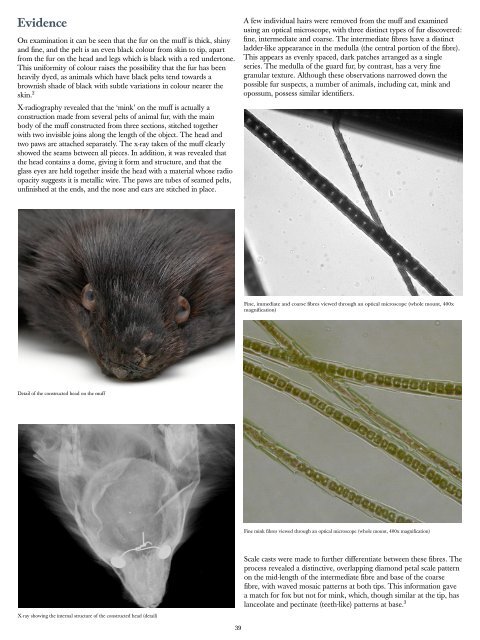FASHION-DETECTIVE
FASHION-DETECTIVE
FASHION-DETECTIVE
You also want an ePaper? Increase the reach of your titles
YUMPU automatically turns print PDFs into web optimized ePapers that Google loves.
Evidence<br />
On examination it can be seen that the fur on the muff is thick, shiny<br />
and fine, and the pelt is an even black colour from skin to tip, apart<br />
from the fur on the head and legs which is black with a red undertone.<br />
This uniformity of colour raises the possibility that the fur has been<br />
heavily dyed, as animals which have black pelts tend towards a<br />
brownish shade of black with subtle variations in colour nearer the<br />
skin. 2<br />
X-radiography revealed that the ‘mink’ on the muff is actually a<br />
construction made from several pelts of animal fur, with the main<br />
body of the muff constructed from three sections, stitched together<br />
with two invisible joins along the length of the object. The head and<br />
two paws are attached separately. The x-ray taken of the muff clearly<br />
showed the seams between all pieces. In addition, it was revealed that<br />
the head contains a dome, giving it form and structure, and that the<br />
glass eyes are held together inside the head with a material whose radio<br />
opacity suggests it is metallic wire. The paws are tubes of seamed pelts,<br />
unfinished at the ends, and the nose and ears are stitched in place.<br />
A few individual hairs were removed from the muff and examined<br />
using an optical microscope, with three distinct types of fur discovered:<br />
fine, intermediate and coarse. The intermediate fibres have a distinct<br />
ladder-like appearance in the medulla (the central portion of the fibre).<br />
This appears as evenly spaced, dark patches arranged as a single<br />
series. The medulla of the guard fur, by contrast, has a very fine<br />
granular texture. Although these observations narrowed down the<br />
possible fur suspects, a number of animals, including cat, mink and<br />
opossum, possess similar identifiers.<br />
Fine, immediate and coarse fibres viewed through an optical microscope (whole mount, 400x<br />
magnification)<br />
Detail of the constructed head on the muff<br />
Fine mink fibres viewed through an optical microscope (whole mount, 400x magnification)<br />
Scale casts were made to further differentiate between these fibres. The<br />
process revealed a distinctive, overlapping diamond petal scale pattern<br />
on the mid-length of the intermediate fibre and base of the coarse<br />
fibre, with waved mosaic patterns at both tips. This information gave<br />
a match for fox but not for mink, which, though similar at the tip, has<br />
lanceolate and pectinate (teeth-like) patterns at base. 3<br />
X-ray showing the internal structure of the constructed head (detail)<br />
39


